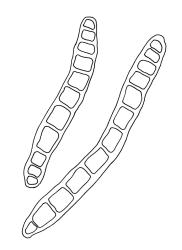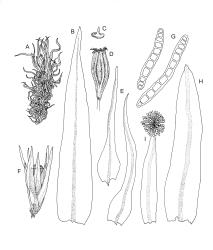- ≡ Plenogemma phyllantha (Brid.) Sawicki, Plášek & Ochyra, Acta Mus. Siles. Sci. Nat. 64: 172 (2015)
Minor elements in the following description are derived from North American specimens.
Plants relatively robust, yellow-brown. Stems sparsely branched by forking, to c. 30 mm in N.Z. material. Leaves erect-spreading when moist, strongly contorted when dry, broadly lanceolate, acute, sometimes narrowly acute, not or scarcely differentiated at base, with margins recurved below, mostly plane above, entire, (2.4–)2.8–3.0(–3.5) × 0.5–0.6 mm (under cover slip); upper laminal cells irregularly rounded, very thick-walled, mostly 9–12 μm in greater diam., unistratose, obscurely or clearly papillose (best seen in profile); basal interior cells elongate, apparently smooth or prorate, yellow, strongly porose, not radiating from the costa; cells of leaf basal margins differentiated in 1 or few rows, with weakly thickened transverse walls, forming a narrow and weak border. Costa stout, ending in the apex or swollen apically and excurrent, usually bearing multicellular gemmae (if gemmae fallen, the costa apex appearing cristate). Gemmae usually present in a dense, ± globose cluster at the costal apex of young leaves, linear to weakly fusiform, red-brown, mostly 165–240 µm, with several (6–)8–10 transverse septa, often fallen and abundant among leaves, occasional germinating in situ.
Reportedly dioicous. Sporophytes unknown from Macquarie I.
Crum & Anderson 1981, fig. 342; Seppelt 2004, fig. 83.
M.
Adventive, or perhaps self-introduced. Patagonia*. Reportedly widespread in maritime areas of northern Europe, western and eastern North America, and eastern Asia (Crum & Anderson 1981).
The Macquarie I. collections seen have no substrate information. Seppelt (2004) stated that most collections are from rock, while some are from "artificial substrates such as weathered rope and old weathered timber" as well as occasionally from "soil or plant roots and litter". Crum & Anderson (1981, p. 721) characterised its habitat in eastern North America (where it is "rare and localised") as "on cliff or boulders, less commonly on the bark of trees, near the sea and often wetted by sea spray". Most Macquarie I. collections are from near sea level, but Seppelt (2004) recorded it occasionally from sites over 200 m elevation. While it is possibly an adventive species on Macquarie I., the possibility that it is self-introduced from Patagonia is equally plausible. Seppelt noted it was first recorded from Macquarie I. in 1978 and that it is more abundant on the west coast of that island.
The few Macquarie I. collections studied have upper laminal cells less obviously papillose than North American material (A.J. Fife 2016 from Newfoundland, CHR 615333). Seppelt (2004) also illustrated more obviously papillose material than I have studied. The pale cells of leaf basal margins in this species are much less differentiated than in other Australasian species of Ulota; the basal border here is narrow (mostly a single row of cells) and obscure.
The eventual discovery of U. phyllantha on other subantarctic islands in the N.Z. botanical region seems likely.







